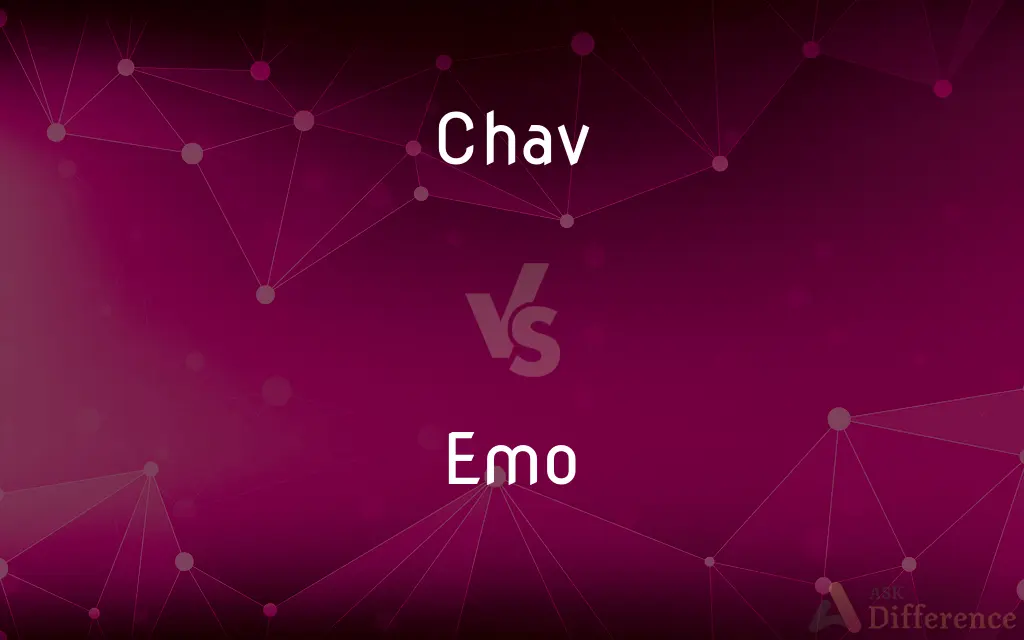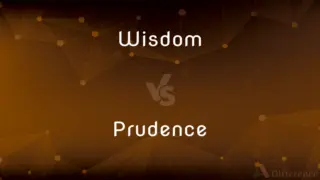Chav vs. Emo — What's the Difference?
By Urooj Arif & Fiza Rafique — Updated on April 7, 2024
"Chav" denotes a brash, loutish young Brit often linked to specific fashions. "Emo" is a rock music style and subculture, noted for emotional lyrics and unique fashion.

Difference Between Chav and Emo
Table of Contents
ADVERTISEMENT
Key Differences
Chav culture is primarily recognized by its fashion, which might include tracksuits, flashy jewelry (often referred to as "bling"), and brand-name sportswear, suggesting a particular lifestyle and attitude that is often perceived as aggressive or confrontational. Emo, short for "emotional hardcore," originated from a style of punk rock music and has evolved into a wider cultural movement that includes a specific fashion sense, such as skinny jeans, tight t-shirts, studded belts, and hairstyles featuring long bangs, often dyed black.
The term "chav" is often used pejoratively to describe individuals seen as having a lack of sophistication or manners, typically from a lower socio-economic background. This stereotype is controversial and considered derogatory by many. In contrast, "emo" is used to denote a group that is more introspective, focusing on emotional expression through music, fashion, and other forms of media. While also subject to stereotype, the emo label tends to emphasize sensitivity and artistic inclination.
Chav culture is closely linked to the UK and is a term with strong class connotations, often invoking discussions about social class and identity in British society. The emo subculture, however, is part of a global music scene with roots in the American punk movement of the 1980s, highlighting its broader cultural and geographic spread.
Individuals identified as chavs are often unfairly stigmatized for their supposed behavior and lifestyle choices, facing criticism for perpetuating a certain image of youth culture. Emo individuals, while also facing their own forms of stereotyping and misunderstanding, are typically characterized by their emotional depth, introspection, and sometimes, a perceived tendency towards melancholy or depression.
Despite these stereotypes, both chav and emo cultures offer a sense of identity and belonging to their members, with each group fostering its own communities, norms, and values. The distinction between the two lies not just in fashion and music but in the broader cultural and social implications associated with each term.
ADVERTISEMENT
Comparison Chart
Origin
British slang
Emotional hardcore punk rock music
Fashion Style
Tracksuits, sportswear, "bling"
Skinny jeans, tight t-shirts, studded belts, distinctive hairstyles
Stereotypical Behavior
Aggressive, confrontational
Sensitive, introspective
Social Connotations
Lower socio-economic background, lack of sophistication
Emotional depth, artistic inclination
Geographic Spread
Primarily UK
Global, with American origins
Compare with Definitions
Chav
Stereotypically associated with lower socio-economic status and aggressive behavior.
Films depicting urban youth sometimes include chav characters to highlight class divides.
Emo
Associated with introspection, sensitivity, and a depth of emotional expression.
Emo subculture places a high value on expressing genuine emotions and feelings.
Chav
Subject to social stigma and stereotyping.
The chav stereotype has been criticized for reinforcing negative class stereotypes.
Emo
Related to a style of rock music emphasizing emotional expression, and the associated subculture.
Emo music's lyrics often deal with personal and emotional topics.
Chav
Known for a distinctive style including brand-name sportswear.
Chav culture has popularized certain sportswear brands as status symbols.
Emo
Global subculture with origins in the American punk scene.
The emo movement has spread worldwide from its roots in 1980s American punk rock.
Chav
A pejorative British term for a young person with a particular brash fashion sense and behavior.
The media often portrays chavs in tracksuits and gold jewelry.
Emo
Sometimes stereotyped for a preoccupation with melancholy or depression.
Despite stereotypes, emo culture encompasses a wide range of emotional expressions.
Chav
Often linked to a specific British urban youth subculture.
The term chav is frequently used in discussions about British social identity and class.
Emo
Fashion includes skinny jeans, distinctive hairstyles, and sometimes dark clothing.
Emo fashion is recognizable by its combination of punk influences and more contemporary styles.
Chav
"Chav" (), also "charver" and "scally" in parts of England is a British pejorative term used to describe an anti-social lower-class youth dressed in sportswear. "Chavette" is a related term referring to female chavs, and the adjectives "chavvy", "chavvish", and "chavtastic" are used to describe things associated with chavs, such as fashion, slang, etc.
Emo
Emo is a rock music genre characterized by an emphasis on emotional expression, sometimes through confessional lyrics. It emerged as a style of post-hardcore from the mid-1980s hardcore punk movement in Washington, D.C., where it was known as emotional hardcore or emocore and pioneered by bands such as Rites of Spring and Embrace.
Chav
Used as a disparaging term for a poor or uneducated young person, especially one who behaves in a brash or vulgar manner and wears ostentatious clothing and jewelry.
Emo
Rock music characterized by confessional lyrics about emotional topics.
Chav
A working-class youth, especially one associated with aggression, poor education, and a perceived "common" taste in clothing and lifestyle.
Emo
A particular style of hardcore punk rock
Emo
An individual of people associated with that subculture and musical style.
Emo
Any form of guitar-driven alternative rock that is particularly or notably emotional
Emo
An individual of people associated with a fashion or stereotype of that style of rock.
Emo
A young person who is considered to be over-emotional or stereotypically emo.
Emo
Emotional; sensitive.
Emo
Depressed.
Emo
Associated with youth subcultures embodying emotional sensitivity.
Common Curiosities
What is the main difference between chav and emo?
The main difference lies in their origins and cultural associations: chav is a British term with class connotations, while emo is associated with a music-driven subculture focused on emotional expression.
What types of music are associated with emo?
Emo music is a subgenre of punk rock known for its expressive, often confessional lyrics, evolving from the hardcore punk scene.
How are chav and emo cultures stereotypically portrayed?
Chav culture is often stereotypically portrayed as aggressive and linked to lower socio-economic status, while emo culture is characterized by sensitivity, introspection, and emotional depth.
Can someone be both chav and emo?
While theoretically possible, the two cultures have distinct identities and values that might not overlap significantly in practice.
How has the emo subculture been received globally?
The emo subculture has been widely adopted and adapted around the world, with local music scenes incorporating its influence.
Are chav and emo subcultures still relevant today?
Both remain relevant, though their prominence and public perception may evolve with changing cultural and social dynamics.
How have chav and emo been represented in media and popular culture?
They've been subject to both stereotyping and more nuanced portrayals, influencing public understanding and discourse around these identities.
Why is the term "chav" considered derogatory?
It's often used to demean people based on class, lifestyle, and fashion choices, reinforcing negative social stereotypes.
What role does fashion play in chav and emo identities?
Fashion is a key component of both identities, serving as a visual marker of group belonging and individual expression.
How do chav and emo cultures reflect broader societal issues?
Both reflect societal attitudes toward youth, class, emotional expression, and identity, often challenging or reinforcing prevailing norms.
Share Your Discovery

Previous Comparison
Inventory vs. Merchandise
Next Comparison
Wisdom vs. PrudenceAuthor Spotlight
Written by
Urooj ArifUrooj is a skilled content writer at Ask Difference, known for her exceptional ability to simplify complex topics into engaging and informative content. With a passion for research and a flair for clear, concise writing, she consistently delivers articles that resonate with our diverse audience.
Co-written by
Fiza RafiqueFiza Rafique is a skilled content writer at AskDifference.com, where she meticulously refines and enhances written pieces. Drawing from her vast editorial expertise, Fiza ensures clarity, accuracy, and precision in every article. Passionate about language, she continually seeks to elevate the quality of content for readers worldwide.
















































